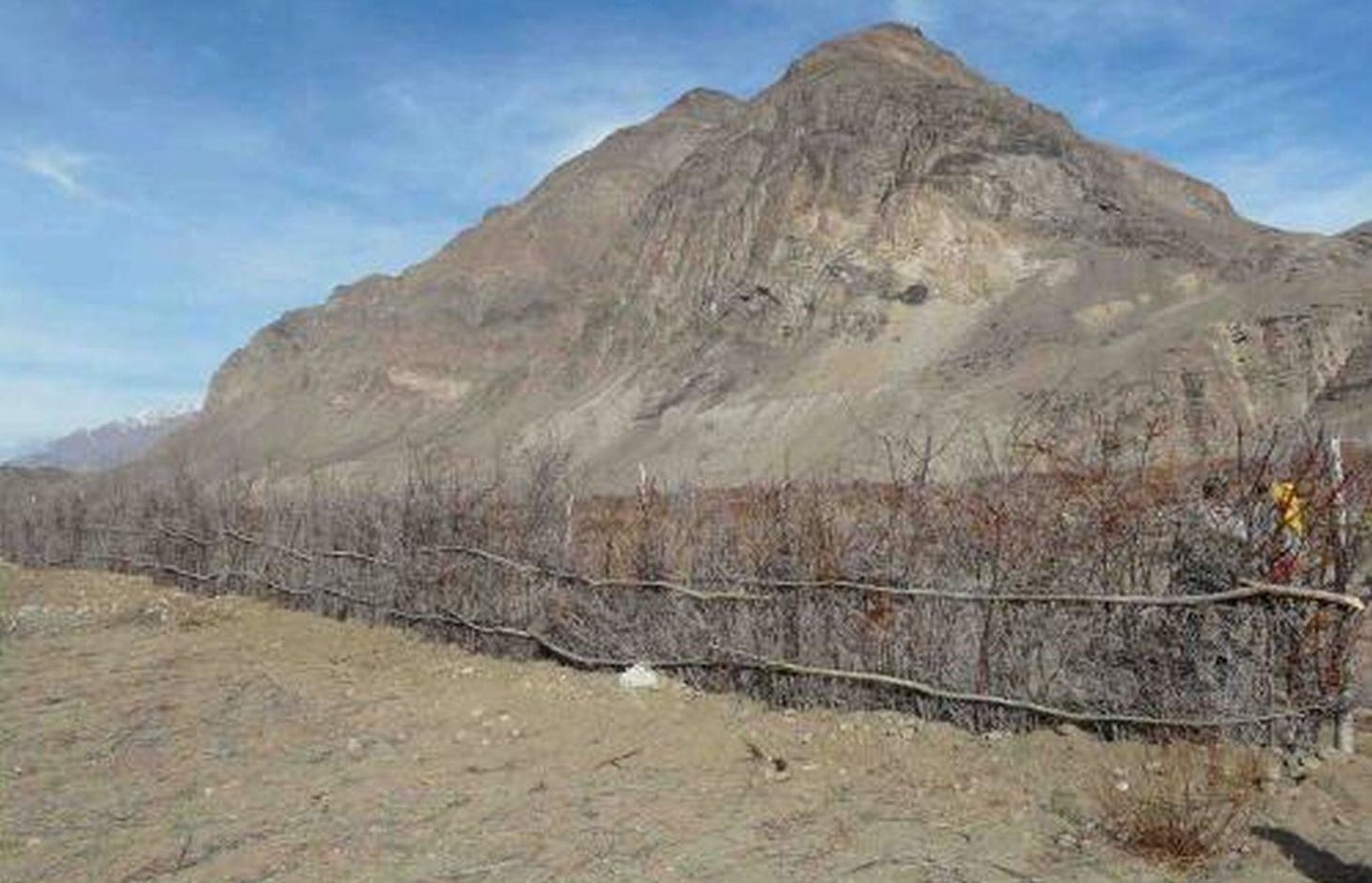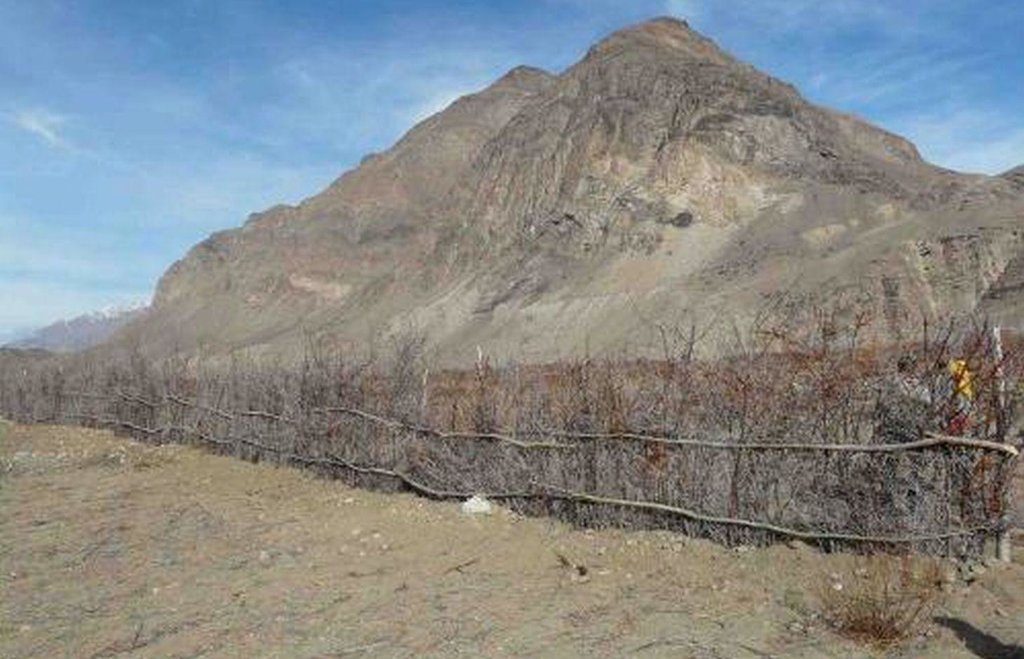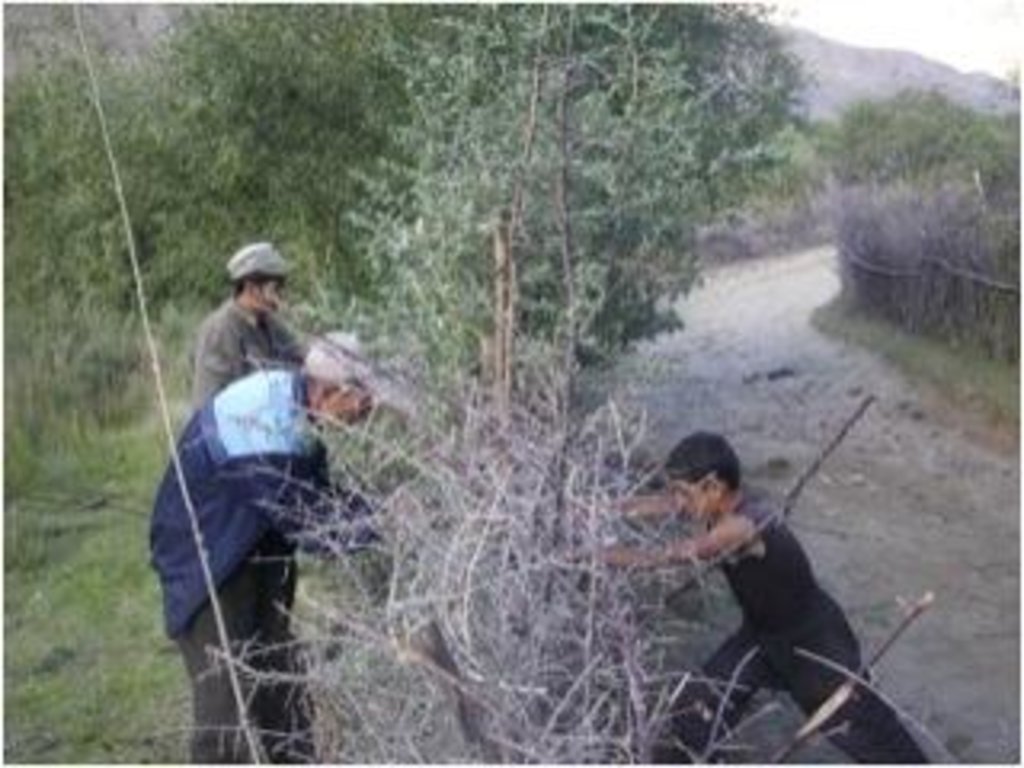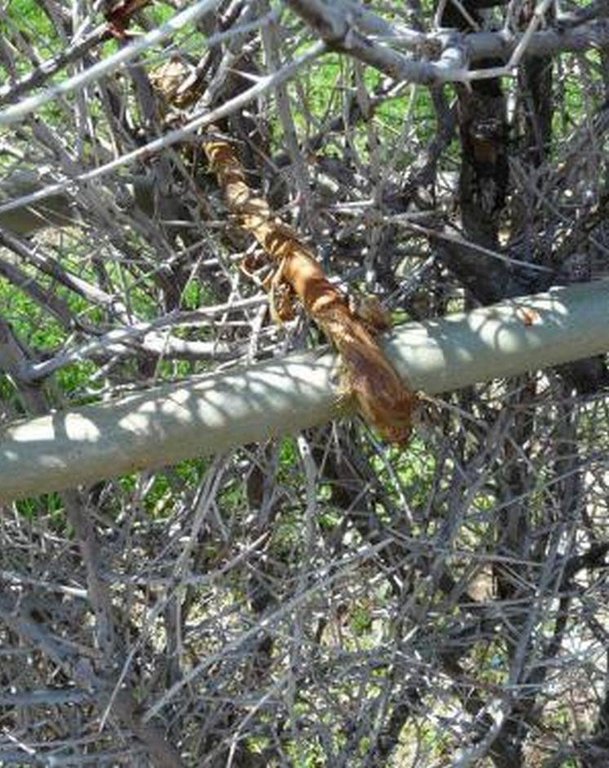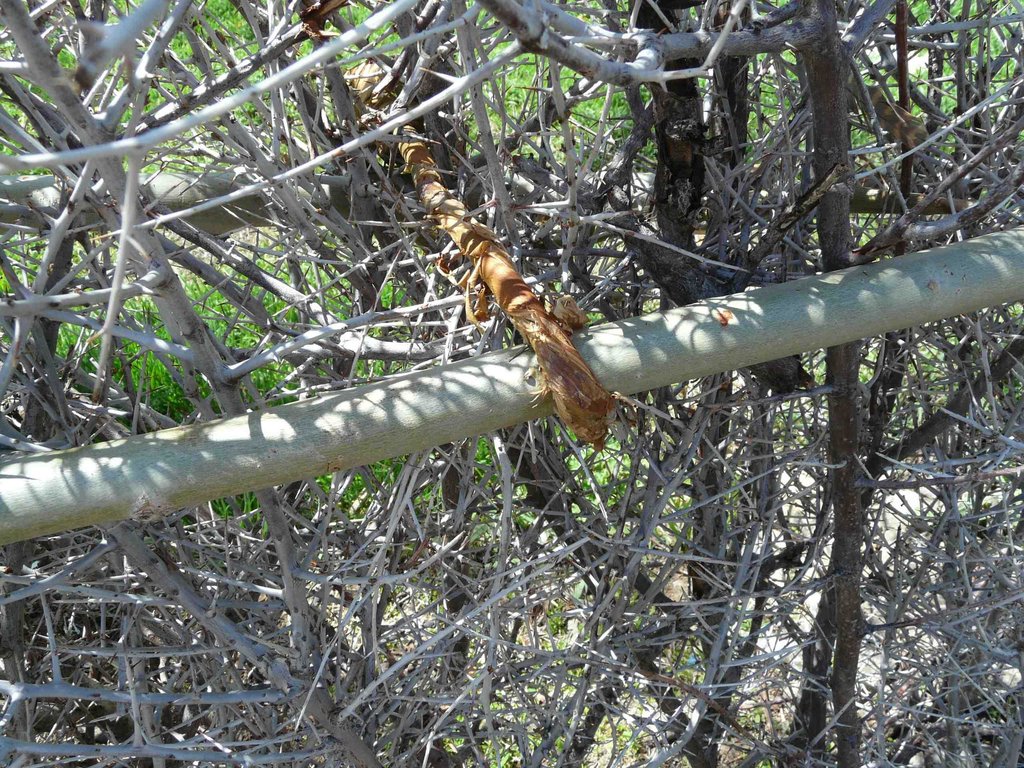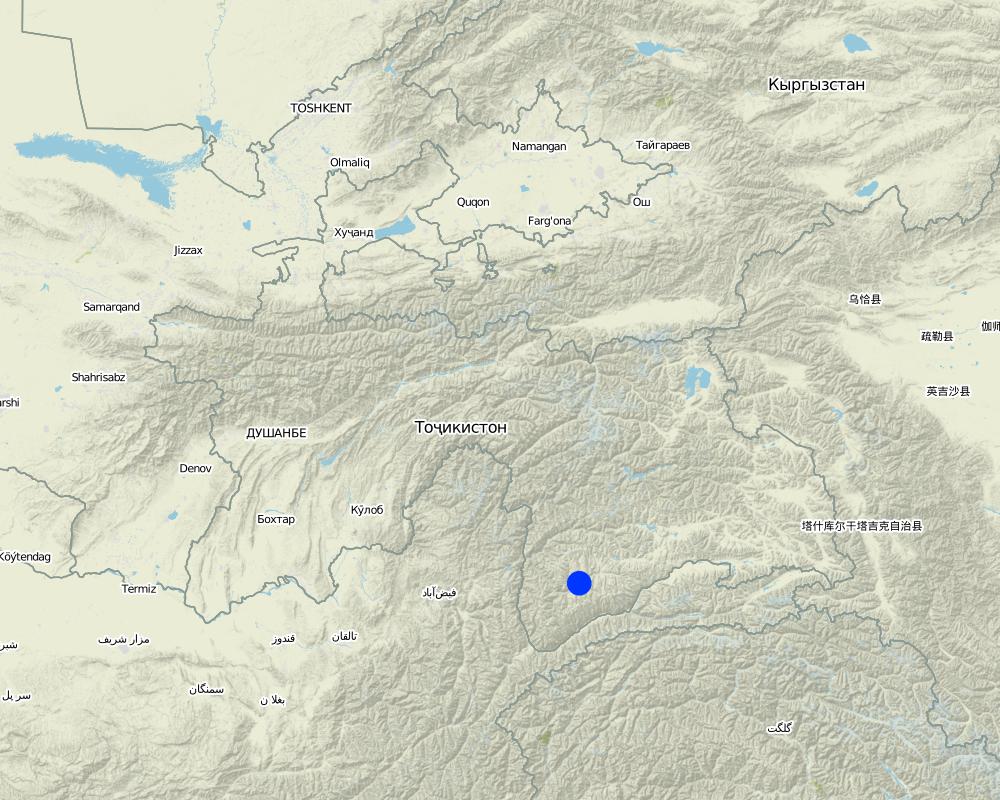Establishment of living seabuckthorn fences for the protection of reforestation sites (CACILM) [Tajikistan]
- Creation:
- Update:
- Compiler: Roziya Kirgizbekova
- Editor: –
- Reviewers: Fabian Ottiger, Alexandra Gavilano
technologies_1036 - Tajikistan
- Full summary as PDF
- Full summary as PDF for print
- Full summary in the browser
- Full summary (unformatted)
- Establishment of living seabuckthorn fences for the protection of reforestation sites (CACILM): Des. 27, 2016 (inactive)
- Establishment of living seabuckthorn fences for the protection of reforestation sites (CACILM): Junie 2, 2017 (inactive)
- Establishment of living seabuckthorn fences for the protection of reforestation sites (CACILM): Julie 22, 2017 (inactive)
- Establishment of living seabuckthorn fences for the protection of reforestation sites (CACILM): Aug. 14, 2019 (public)
View sections
Expand all Collapse all1. General information
1.2 Contact details of resource persons and institutions involved in the assessment and documentation of the Technology
Key resource person(s)
SLM specialist:
Angermann Michael
Deutsche Gesellschaft für Internationale Zusammenarbeit (GIZ) GmbH,
Tajikistan
SLM specialist:
Neusel Benjamin
Deutsche Gesellschaft für Internationale Zusammenarbeit (GIZ) GmbH,
Tajikistan
SLM specialist:
Kirchhoff Joachim F.
GIZ GmbH,
Name of project which facilitated the documentation/ evaluation of the Technology (if relevant)
Central Asian Countries Initiative for Land Management (CACILM I)Name of the institution(s) which facilitated the documentation/ evaluation of the Technology (if relevant)
Deutsche Gesellschaft für Internationale Zusammenarbeit (GIZ) GmbH (GIZ) - Germany1.3 Conditions regarding the use of data documented through WOCAT
The compiler and key resource person(s) accept the conditions regarding the use of data documented through WOCAT:
Ja
1.5 Reference to Questionnaire(s) on SLM Approaches (documented using WOCAT)
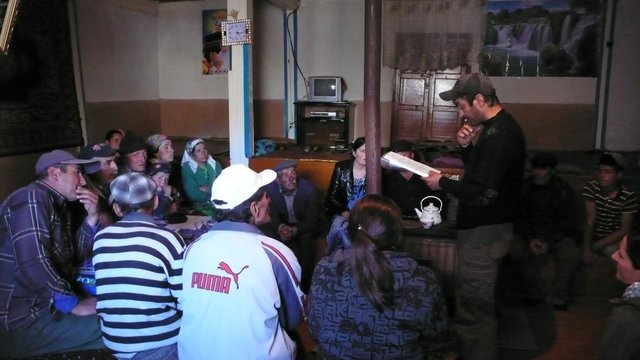
Savings Book Approach [Tajikistan]
Reforestation of deserted state forest plots through a financial incentive system for the labour intensive first years of forest establishment, after which harvests of forest products from the plot provide income opportunities for the forest tenants and the State Forestry Agency (in the frame of CACILM).
- Compiler: Roziya Kirgizbekova
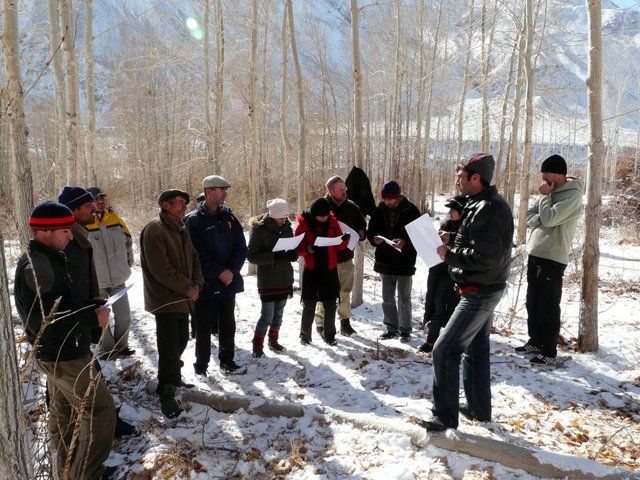
Joint Forest Management (JFM) [Tajikistan]
Protection and rehabilitation of state forests based on joint long term agreements set up between the State Forestry Agency, and local forest users (in the frame of CACILM).
- Compiler: Roziya Kirgizbekova
2. Description of the SLM Technology
2.1 Short description of the Technology
Definition of the Technology:
Protection of reforestation sites (willow, poplar and fruit trees) through living seabuckthorn perimeter fencing on Joint Forestry Management plots.
2.2 Detailed description of the Technology
Description:
In the heavily degraded flood plain forests of the Pamirs in eastern Tajikistan, living fences made out of seabuckthorn are protecting reforestation and Joint Forestry Management (JFM) sites. A living seabuckthorn fence consists of two layers. The outer layer is an instant fence made of thorny seabuсkthorn branches. The purpose of the outer layer is to immediately restrict animal and human access to the reafforestation site. The outer layer also buffers the inner layer of seabuckthorn, which is planted from seabuckthorn seedlings. The inner layer will establish itself over a number of seasons, eventually growing to a height of 1.5-2m. Once established, the seabuckthorn bush provides a low cost sustainable perimeter fence to protect reforestation activities. The bush also produces fruits for processing (in the frame of CACILM)
Purpose of the Technology: The purpose of this technology is to improve heavily degraded forest areas and establish new areas by restricting open access to the human population and preventing uncontrolled livestock grazing. As part of the Joint Forestry Management approach, these reforested areas are leased to the land user providing long-term legal control, as well as income opportunities for the tenants and the State Forestry Agency.
Establishment / maintenance activities and inputs: As part of the Joint Forestry Management approach (TAJ015), land is allocated by the State Forestry Agency to a designated land user. Once the size of the plot is established, a solid fence constructed of off-cuts of seabuckthorn and supported by willow poles is established around the perimeter of the JFM reforestation area. The seabuckthorn branches are fixed together with willow twigs, willow branches or wire and are attached to wooden poles. Once completed, seabuckthorn seedlings are planted at 0.5m intervals along a small irrigation channel on the inner side of the perimeter fence. After a few seasons these seedlings will grow into a natural living fence, which will take over the protection role from the perimeter fence constructed from off-cuts. The reforestion area is planted with branches of willow and poplar and interspersed with fruit trees. Reforestation planting materials are readily available in most parts of GBAO, and the Forestry Agency facilitates free access to seabuckthorn branches, willow branches and wooden poles. If required, wire and tools are provided by the JFM project.
Natural / human environment: The natural forest cover and biological diversity in many areas of GBAO has been significantly degraded. While population density in GBAO is low, natural resources are scarce due to the high altitude mountain environment and the pressure on these resources is great. In Soviet times, the Pamir region was highly dependent on subsidized coal from other parts of the Soviet Union. After independence, coal was no longer available and other fuel had to be sourced. Population pressure, poverty, and the lack of established local level institutions to manage forest lands have rendered forest areas an open access resource where the local population harvests forest products and grazes livestock without regulation. The local Forestry Agencies do not have the capacity to control overuse or to implement sustainable forestry management. As a part of the Joint Forestry Management approach (TAJ015) this SLM technology is a reintroduction of a traditional method for the protection of reforestation sites against livestock and, additionally, it clearly demarcates forest plot ownership and boundaries.
2.3 Photos of the Technology
2.5 Country/ region/ locations where the Technology has been applied and which are covered by this assessment
Country:
Tajikistan
Region/ State/ Province:
Tajikistan, Gorno Badakhshan Autonomous Region (GBAO)
Further specification of location:
Ishkashim, Roshtkala and Shugnan Districts
Comments:
Total area covered by the SLM Technology is 20 km2.
Map
×2.6 Date of implementation
If precise year is not known, indicate approximate date:
- less than 10 years ago (recently)
2.7 Introduction of the Technology
Specify how the Technology was introduced:
- through projects/ external interventions
Comments (type of project, etc.):
Living seabuckthorn fencing is a traditional/indigenous method used for many years in the Pamirs. This technology has more recently been promoted by the project for the protection of forest plots under JFM. Similarly, the tree planting techniques used also follow traditionally applied methods in the Pamirs.
3. Classification of the SLM Technology
3.2 Current land use type(s) where the Technology is applied

Forest/ woodlands
- plantation forestry
- Seabuckthorn
Products and services:
- Timber
- Fuelwood
- Fruits and nuts
- Other forest products
- Nature conservation/ protection
- Protection against natural hazards
Comments:
Major land use problems (compiler’s opinion): Open access to forests leads to illegal use and destruction of forests; grazing of livestock within forest areas hinder regeneration of forests.
Major land use problems (land users’ perception): Shortage of fuel wood for cooking and heating; lack of pastures and fodder for maintaining or increasing livestock herds; land degradation and increasing vulnerability to natural hazard periods
Selective felling of (semi-) natural forests: Yes
Plantation forestry: Yes
Problems / comments regarding forest use: For now most of the forest plots are strongly degraded natural and formerly forested areas. So far felling is strongly restricted and permitted only where afforestation is conducted.
Forest products and services: timber, fuelwood, fruits and nuts, other forest products / uses (honey, medical, etc.), nature conservation / protection, protection against natural hazards
Future (final) land use (after implementation of SLM Technology): Forests / woodlands: Fp: Plantations, afforestations
3.3 Has land use changed due to the implementation of the Technology?
Has land use changed due to the implementation of the Technology?
- Yes (Please fill out the questions below with regard to the land use before implementation of the Technology)
Land use mixed within the same land unit:
Ja
Specify mixed land use (crops/ grazing/ trees):
- Silvo-pastoralism

Forest/ woodlands
- Tree plantation, afforestation
3.6 SLM measures comprising the Technology

vegetative measures
- V1: Tree and shrub cover

management measures
- M5: Control/ change of species composition
Comments:
Main measures: vegetative measures
Secondary measures: management measures
Type of vegetative measures: aligned: -along boundary
3.7 Main types of land degradation addressed by the Technology

soil erosion by wind
- Et: loss of topsoil
- Eo: offsite degradation effects

biological degradation
- Bc: reduction of vegetation cover
- Bh: loss of habitats
Comments:
Main causes of degradation: deforestation / removal of natural vegetation (incl. forest fires), over-exploitation of vegetation for domestic use, land tenure, governance / institutional (Lack of human and material resources of Forest Agency)
Secondary causes of degradation: overgrazing, population pressure, poverty / wealth, war and conflicts (Lack of energy resources during civil war)
3.8 Prevention, reduction, or restoration of land degradation
Comments:
Main goals: rehabilitation / reclamation of denuded land
Secondary goals: prevention of land degradation, mitigation / reduction of land degradation
4. Technical specifications, implementation activities, inputs, and costs
4.1 Technical drawing of the Technology
Technical specifications (related to technical drawing):
Living seabuckthorn fence: The dead part of the fence prevents livestock from entering the forest plot, while in the long run the planted seedlings take over this role by forming a dense living seabuckthorn barrier.
Location: -. Gorno Badakhshan, Tajikistan
Date: February 2011
Technical knowledge required for field staff / advisors: low
Technical knowledge required for land users: moderate (It is not a difficult technology to implement.)
Main technical functions: improvement of ground cover, stabilisation of soil (eg by tree roots against land slides), increase of biomass (quantity)
Secondary technical functions: increase / maintain water stored in soil, water harvesting / increase water supply, water spreading, reduction in wind speed, promotion of vegetation species and varieties (quality, eg palatable fodder)
Aligned: -along boundary
Vegetative material: T : trees / shrubs
Number of plants per (ha): 400-800
Vertical interval within rows / strips / blocks (m): 0.5
Trees/ shrubs species: seabuckthorn (Hippophae rhamnoides)
Change of land use type: Enclosure of the plot, change from grazing to forest
Change of land use practices / intensity level: Change from open access to controlled access (fence)
Control / change of species composition
Author:
Hahnewald/Gaude/Rosset
4.2 General information regarding the calculation of inputs and costs
other/ national currency (specify):
Tajik Somoni
If relevant, indicate exchange rate from USD to local currency (e.g. 1 USD = 79.9 Brazilian Real): 1 USD =:
4.5
Indicate average wage cost of hired labour per day:
7.00
4.3 Establishment activities
| Activity | Timing (season) | |
|---|---|---|
| 1. | Establishment of living seabuckthorn fence | Any time |
| 2. | Planting of poplar and willows | early spring |
| 3. | Planting of fruit trees | early spring |
4.4 Costs and inputs needed for establishment
| Specify input | Unit | Quantity | Costs per Unit | Total costs per input | % of costs borne by land users | |
|---|---|---|---|---|---|---|
| Labour | Establishment of living seabuckthorn fence | Mandays | 160.0 | 6.6625 | 1066.0 | 100.0 |
| Labour | Planting of poplar and willows | Mandays | 40.0 | 6.65 | 266.0 | 100.0 |
| Labour | Planting of fruit trees | Mandays | 3.0 | 6.666 | 20.0 | 100.0 |
| Equipment | Tools | piece | 4.0 | 5.5 | 22.0 | |
| Plant material | Seedlings Seabuckthorn | piece | 2000.0 | 0.2225 | 445.0 | |
| Plant material | Seedlings of poplar and willows | piece | 1200.0 | 0.22166 | 265.99 | |
| Plant material | Seedlings fruit trees | piece | 50.0 | 1.11 | 55.5 | 100.0 |
| Construction material | Wood | 360 cub per m | 1000.0 | 0.8 | 800.0 | |
| Construction material | Wire | m | 1000.0 | 0.111 | 111.0 | |
| Total costs for establishment of the Technology | 3051.49 | |||||
| Total costs for establishment of the Technology in USD | 678.11 | |||||
Comments:
Duration of establishment phase: 1 month(s)
4.5 Maintenance/ recurrent activities
| Activity | Timing/ frequency | |
|---|---|---|
| 1. | Fence repair | spring, annually |
| 2. | Plant tending | spring, annually |
4.6 Costs and inputs needed for maintenance/ recurrent activities (per year)
| Specify input | Unit | Quantity | Costs per Unit | Total costs per input | % of costs borne by land users | |
|---|---|---|---|---|---|---|
| Labour | Fence repair | Mandays | 3.0 | 6.666 | 20.0 | 100.0 |
| Labour | Plant tending | Mandays | 4.0 | 6.75 | 27.0 | 100.0 |
| Equipment | Tools | piece | 2.0 | 13.5 | 27.0 | |
| Plant material | 8.0 | |||||
| Construction material | Wood | 2 cub per m | 1000.0 | 0.0089 | 8.9 | 100.0 |
| Construction material | Wire | meter | 10.0 | 0.1 | 1.0 | 100.0 |
| Total costs for maintenance of the Technology | 83.9 | |||||
| Total costs for maintenance of the Technology in USD | 18.64 | |||||
Comments:
Machinery/ tools: Spades, scissors, picks, gloves, planting bars.
The costs were calculated for 1000m of live seabuckthorn fence and approximately 1ha of tree planting, including 50 fruit trees and 1200 poplars and willows. Costs were calculated in April 2011. It is assumed that seabuckthorn and wood for poles are readily available on the forest plot or can be provided by the State Forestry Agency from nearby plots. Seedlings needed for the live part of the fence are very small parts of seabuckthorn plants, which are available as well wherever seabuckthorn grows. Tools are provided through the Joint Forestry Management project for the period they are needed for construction and maintenance. The mentioned enrichment plantings do not apply to every plot to the same extent. These also highly depend on the motivation and interest of the tenant.
4.7 Most important factors affecting the costs
Describe the most determinate factors affecting the costs:
The seabuckthorn seedlings are readily available in the area of implementation and incur no financial cost to the forest tenant. The labour is provided by the forest tenant. Labour is potentially a major expense if the land user must pay for it. Factors that contribute to the amount of labour required include the distance the seabuckthorn wood and seedlings have to be transported and the soil texture for the digging of a trench for the erection of the fence.
So far, the material needed for fencing and tree planting has been provided free of charge by the Forestry Agency. The only financial cost to the land user is the cost of the fruit trees, approximately 5 som per sapling. The land is provided by the Forestry Agency free of charge, however percentages of harvested forest products have to be paid to the Forestry Agency as the land owner's share.
5. Natural and human environment
5.1 Climate
Annual rainfall
- < 250 mm
- 251-500 mm
- 501-750 mm
- 751-1,000 mm
- 1,001-1,500 mm
- 1,501-2,000 mm
- 2,001-3,000 mm
- 3,001-4,000 mm
- > 4,000 mm
Specifications/ comments on rainfall:
Spring and autumn are (moderate) rainy seasons, summer is a dry period of min. 3 months
Agro-climatic zone
- arid
Thermal climate class: temperate. continental climate, cold winters but warm, rather long summers
5.2 Topography
Slopes on average:
- flat (0-2%)
- gentle (3-5%)
- moderate (6-10%)
- rolling (11-15%)
- hilly (16-30%)
- steep (31-60%)
- very steep (>60%)
Landforms:
- plateau/plains
- ridges
- mountain slopes
- hill slopes
- footslopes
- valley floors
Altitudinal zone:
- 0-100 m a.s.l.
- 101-500 m a.s.l.
- 501-1,000 m a.s.l.
- 1,001-1,500 m a.s.l.
- 1,501-2,000 m a.s.l.
- 2,001-2,500 m a.s.l.
- 2,501-3,000 m a.s.l.
- 3,001-4,000 m a.s.l.
- > 4,000 m a.s.l.
Indicate if the Technology is specifically applied in:
- convex situations
Comments and further specifications on topography:
Footslopes only where there is sufficient water coming from the gorges. Flood plain forests in the valley floors (convex). Flood plain forests in valley floors, flat areas.
5.3 Soils
Soil depth on average:
- very shallow (0-20 cm)
- shallow (21-50 cm)
- moderately deep (51-80 cm)
- deep (81-120 cm)
- very deep (> 120 cm)
Soil texture (topsoil):
- coarse/ light (sandy)
Topsoil organic matter:
- low (<1%)
5.4 Water availability and quality
Ground water table:
< 5 m
Availability of surface water:
medium
Water quality (untreated):
good drinking water
Is water salinity a problem?
Nee
5.5 Biodiversity
Species diversity:
- medium
5.6 Characteristics of land users applying the Technology
Market orientation of production system:
- subsistence (self-supply)
- mixed (subsistence/ commercial)
Off-farm income:
- > 50% of all income
Relative level of wealth:
- poor
Individuals or groups:
- individual/ household
Gender:
- men
Indicate other relevant characteristics of the land users:
Land users applying the Technology are mainly common / average land users
Difference in the involvement of women and men: Women are encouraged to participate, but as the work consists in rather strenuous forestry work, it is mainly applied by men.
Population density: < 10 persons/km2
Annual population growth: 1% - 2%
10% of the land users are average wealthy.
80% of the land users are poor (mostly villagers with no formal employment).
10% of the land users are poor.
Off-farm income specification: Mostly subsistence farming. Income mainly from remittances and formal employment.
5.7 Average area of land used by land users applying the Technology
- < 0.5 ha
- 0.5-1 ha
- 1-2 ha
- 2-5 ha
- 5-15 ha
- 15-50 ha
- 50-100 ha
- 100-500 ha
- 500-1,000 ha
- 1,000-10,000 ha
- > 10,000 ha
Is this considered small-, medium- or large-scale (referring to local context)?
- small-scale
Comments:
Average area of land owned or leased by land users applying the Technology: 0.5-1 ha, 1-2 ha, 2-5 ha, 5-15 ha
5.8 Land ownership, land use rights, and water use rights
Land ownership:
- state
Land use rights:
- leased
Water use rights:
- communal (organized)
Comments:
Forest plots of the State Forestry Agency are leased to local forest tenants according to the procedure described in the approach TAJ015 "Joint Forestry Management". Therefore the tenants hold 20-years management and user rights specified in the contract for the leased plots. The technology is applied on these forest plots leased by the State Forestry Agency. Water use rights are strictly regulated on a communal basis, whereas use rights for forest plots have to be negotiated on a communal basis as well.
5.9 Access to services and infrastructure
health:
- poor
- moderate
- good
education:
- poor
- moderate
- good
technical assistance:
- poor
- moderate
- good
employment (e.g. off-farm):
- poor
- moderate
- good
markets:
- poor
- moderate
- good
energy:
- poor
- moderate
- good
roads and transport:
- poor
- moderate
- good
drinking water and sanitation:
- poor
- moderate
- good
financial services:
- poor
- moderate
- good
6. Impacts and concluding statements
6.1 On-site impacts the Technology has shown
Socio-economic impacts
Production
fodder production
wood production
Quantity after SLM:
2-10m3
Comments/ specify:
Before: illegal open access
product diversity
Comments/ specify:
non-timber forest products
energy generation
Water availability and quality
irrigation water availability
Income and costs
diversity of income sources
Socio-cultural impacts
food security/ self-sufficiency
health situation
SLM/ land degradation knowledge
situation of socially and economically disadvantaged groups
Ecological impacts
Water cycle/ runoff
surface runoff
Soil
soil moisture
soil cover
soil loss
Biodiversity: vegetation, animals
biomass/ above ground C
plant diversity
habitat diversity
Climate and disaster risk reduction
wind velocity
6.2 Off-site impacts the Technology has shown
downstream flooding
wind transported sediments
6.3 Exposure and sensitivity of the Technology to gradual climate change and climate-related extremes/ disasters (as perceived by land users)
Gradual climate change
Gradual climate change
| Season | increase or decrease | How does the Technology cope with it? | |
|---|---|---|---|
| annual temperature | increase | well |
Climate-related extremes (disasters)
Meteorological disasters
| How does the Technology cope with it? | |
|---|---|
| local rainstorm | not well |
| local windstorm | well |
Climatological disasters
| How does the Technology cope with it? | |
|---|---|
| drought | not well |
Hydrological disasters
| How does the Technology cope with it? | |
|---|---|
| general (river) flood | not well |
Other climate-related consequences
Other climate-related consequences
| How does the Technology cope with it? | |
|---|---|
| reduced growing period | not well |
6.4 Cost-benefit analysis
How do the benefits compare with the establishment costs (from land users’ perspective)?
Short-term returns:
slightly negative
Long-term returns:
positive
How do the benefits compare with the maintenance/ recurrent costs (from land users' perspective)?
Short-term returns:
neutral/ balanced
Long-term returns:
positive
6.5 Adoption of the Technology
- > 50%
If available, quantify (no. of households and/ or area covered):
80% = 333 number of land user families / 85% of the area
Of all those who have adopted the Technology, how many did so spontaneously, i.e. without receiving any material incentives/ payments?
- 51-90%
Comments:
20% of land user families have adopted the Technology with external material support
83 land user families have adopted the Technology with external material support
Comments on acceptance with external material support: Material support was only provided where necessary inputs were not available but fencing nonetheless was crucial for the rehabilitation of the site.
80% of land user families have adopted the Technology without any external material support
333 land user families have adopted the Technology without any external material support
Comments on spontaneous adoption: For some forest areas a fence was established around the whole forest plot (not around each tenants individual plot), significantly reducing the workload as compared to the calculated costs.
There is a moderate trend towards spontaneous adoption of the Technology
6.7 Strengths/ advantages/ opportunities of the Technology
| Strengths/ advantages/ opportunities in the land user’s view |
|---|
|
Ownership for a demarcated forest plot. How can they be sustained / enhanced? Support trust in the ownership among tenants, effective collaboration with the Forestry Agency. |
|
Increased income opportunities if regeneration of forests is improved, and legal access to fuelwood for subsistence. How can they be sustained / enhanced? Support the establishment of marketing opportunities. |
|
Technology is easy to implement and non-available materials are provided. How can they be sustained / enhanced? Encourage building of living seabuckthorn fences and provide access to places where building materials are available. |
| Strengths/ advantages/ opportunities in the compiler’s or other key resource person’s view |
|---|
|
Use of locally available material and indigenous species, therefore low level of external input. How can they be sustained / enhanced? Support availability and spatial distribution of seabuckthorn for fencing, establish nurseries for seabuckthorn seedlings. |
|
Implementation and promotion of traditionally used technology. How can they be sustained / enhanced? Training to show advantages and sustainability of the traditional fencing technique. |
|
Effective protection of forest areas, protection of planted seedlings, support of natural regeneration. How can they be sustained / enhanced? Support the establishment of marketing opportunities for forest products and highlight the increased income and harvest opportunities if forests are protected and growing well. |
|
Sustainability through the planting of seabuckthorn seedlings and the evolution towards a living seabuckthorn fence. How can they be sustained / enhanced? Highlight the lower maintenance costs once the fence is naturally growing and dense. |
|
Potential for further processing of seabuckthorn. How can they be sustained / enhanced? Support the establishment of sustainable and market-oriented structures for seabuckthorn and other NTFP processing. |
6.8 Weaknesses/ disadvantages/ risks of the Technology and ways of overcoming them
| Weaknesses/ disadvantages/ risks in the land user’s view | How can they be overcome? |
|---|---|
| Livestock cannot be grazed on forest areas. | Trainings and participatory discussions on opportunities to increase fodder and pasture availability, including "cut and carry" systems and increased production of perennial and other fodder crops within the forest plots. |
| High workload for fencing and planting. | Highlight the longterm income and subsistence opportunities when increased amounts of forest products can be harvested and support the creation of value chains and marketing options for forest products. |
| Weaknesses/ disadvantages/ risks in the compiler’s or other key resource person’s view | How can they be overcome? |
|---|---|
| Conflicts might arise within the village between the interest of protecting and supporting regeneration of the forest and the interest of villagers to graze their livestock on the forest plots. | Facilitation of integrated land management including forestry, pasture management and irrigation; facilitation of civil society organization formation. |
7. References and links
7.1 Methods/ sources of information
Links and modules
Expand all Collapse allLinks

Savings Book Approach [Tajikistan]
Reforestation of deserted state forest plots through a financial incentive system for the labour intensive first years of forest establishment, after which harvests of forest products from the plot provide income opportunities for the forest tenants and the State Forestry Agency (in the frame of CACILM).
- Compiler: Roziya Kirgizbekova

Joint Forest Management (JFM) [Tajikistan]
Protection and rehabilitation of state forests based on joint long term agreements set up between the State Forestry Agency, and local forest users (in the frame of CACILM).
- Compiler: Roziya Kirgizbekova
Modules
No modules


